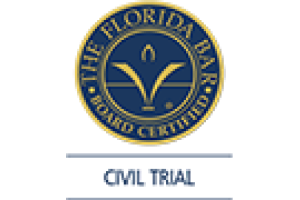Client Reviews
Road Construction Accidents
Highway work zones are some of the most dangerous within the construction industry. According to recent research from the National Institute for Occupational Safety and Health (NIOSH), Florida ranked No. 2 in terms of the most motor vehicle crash fatalities in work zones, with more than 60 deaths and thousands of injuries annually.
At Associates and Bruce L. Scheiner, Attorneys for the Injured, we are experienced in representing those injured in road construction accidents. We recognize that road construction and maintenance is critical to our societal infrastructure and motorist safety. But these areas are also extremely hazardous.
Drivers must navigate a complex and sometimes confusing system of cones, barrels, signs and lane changes. Workers must manage a minefield of heavy equipment, flashing lights, noisy vehicles and heavy, sometimes hazardous materials.
Careless drivers who ignore warning signs and speed limits are undoubtedly a major concern for workers on these projects. But employers too often fail to properly establish work sites or follow best practices, which puts workers unnecessarily at risk of serious injury or even death.
In 2010, more than 500 were killed in road construction accidents for the first time, according to the National Work Zone Safety Clearinghouse. By 2017, more than 700 were killed in the U.S. Most were working on site at the time of the accident, while about 15 percent were passing through. (These figures do not include the hundreds of motorists who are killed annually while driving through road construction zones.)
Of the hundreds of occupational road construction work zone deaths tallied nationally in 2013, nearly 65 percent occurred in the following industries:
- Construction laborers
- Highway maintenance workers
- Tractor trailer truck drivers
- Supervisors
- Heavy equipment operators
The majority of these worked in private sector construction, and about 10 percent worked for state or local governments.
The Centers for Disease Control and Prevention report transportation incidents account for more than 65 percent of all roadway worker injuries. In nearly 70 percent of those, the incident involves a pedestrian worker hit by a vehicle. About a third of these cases involve workers who were struck by vehicles that were backing up. Twelve percent of all highway fatalities involve large trucks.
The National Highway Traffic Safety Administration reports more than 60 road construction workers are killed in motor vehicle accidents in Florida each year, accounting for roughly 3 percent of the total number of traffic deaths. Only Texas, with 104 road construction worker deaths, averages more fatal accidents.
Across the country, there are 38,000 injuries reported at road construction work zones each year. What that means is there is a work zone injury every 14 minutes, and more than 100 each day, with most of those occurring during the week in daylight hours.
While work zone fatalities have been on the decline in recent years, it’s clear our construction workers still are not getting the kind of on-the-job protection they have the right to expect. Government spends approximately $148 billion annually on highway expenditures for construction, rehabilitation, enhancements and maintenance, according to the Federal Highway Administration (FHWA).
Protecting Workers at Road Construction Sites
Traffic safety researchers have identified a number of methods shown to prevent occupational road construction deaths. Those include:
- Well-designed traffic control plans.
- Traffic control devices and set-ups that are well-maintained.
- Advance warning signs that are clear and visible.
- Adequate traveler information and public outreach concerning the project, particularly longer-term projects.
- Effective use of certain operational strategies, such as signal timing adjustments, queue management and speed reminders and enforcement.
The Bureau of Labor Statistics sets guidelines for how to establish and maintain road construction sites, including signs, channeling devices, flaggers and worker safety. In particular, Section 6D.03 of the Manual on Uniform Traffic Control Devices outlines “Worker safety consideration” in work zones.
These steps include:
- Making sure workers – all of them on site – are trained on the best practices when working next to motor vehicle traffic so that their vulnerability is minimized.
- Erecting temporary traffic barriers along the work space, factoring in of course things like the duration and type of operation, the time of day most work occurs and typical traffic volumes.
- Reducing speed through the use of uniformed law enforcement or flaggers, regulator speed zoning, funneling or lane reduction.
- Ensuring the internal work area is properly planned to reduce the risk of backovers by construction equipment.
- Having a trained person on site to conduct basic hazard assessment on a routine basis. This person makes sure OSHA guidelines are followed and all necessary personal protection measures are taken.
Site owners or supervising firms who fail to ensure worker safety can be held liable. So too can third-parties, such as reckless or careless drivers. That’s in addition to what workers can collect through workers’ compensation.
Call our experienced legal team today to learn more about how we can help.
Contact Associates and Bruce L. Scheiner, Attorneys for the Injured, for a free and confidential consultation to discuss your rights. There are no fees or costs unless we win. Offices in Fort Myers, Cape Coral, Naples and Port Charlotte.
Call 800-646-1210 for a Free Consultation












